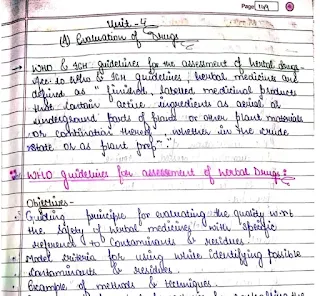Evaluation of Drugs: Hand Written Notes
Evaluation of Drugs
WHO & ICH guidelines for the assessment of herbal drugs
Stability testing of herbal drugs
Detailed Explanation
Evaluating herbal drugs is a crucial aspect of ensuring their safety, efficacy, and quality. The World Health Organization (WHO) and the International Council for Harmonisation of Technical Requirements for Pharmaceuticals for Human Use (ICH) provide comprehensive guidelines for the assessment of herbal drugs.
The WHO guidelines emphasize the importance of proper identification, characterization, and standardization of herbal materials. These guidelines ensure that herbal drugs are consistently produced and controlled according to quality standards appropriate for their intended use. The evaluation process includes verifying the identity of the herbal materials, assessing their quality, and ensuring that they are free from contaminants such as heavy metals, pesticides, and microbial contaminants.
ICH guidelines, particularly those related to stability testing, are also applicable to herbal drugs. Stability testing is essential for determining the shelf life of herbal products and ensuring that they retain their quality, safety, and efficacy throughout their shelf life. The stability testing process involves subjecting the herbal products to various environmental conditions, such as temperature, humidity, and light, to evaluate how these factors affect the product's stability over time.
Herbal drug evaluation also includes assessing the pharmacological and toxicological properties of the herbal materials. This involves conducting studies to understand the therapeutic effects, dosage, and potential side effects of the herbal drugs. These studies help in establishing the safety profile of the herbal products and ensuring that they do not pose any risk to consumers.
In addition to WHO and ICH guidelines, regulatory authorities in different countries have their own specific requirements for the evaluation of herbal drugs. These requirements may include additional tests and documentation to ensure the safety and efficacy of herbal products available in the market.
Overall, the evaluation of herbal drugs is a comprehensive process that involves multiple steps to ensure their quality, safety, and efficacy. By adhering to WHO and ICH guidelines, manufacturers can produce high-quality herbal products that meet regulatory standards and provide therapeutic benefits to consumers.
Info!
If you are the copyright owner of this document and want to report it, please visit the copyright infringement notice page to submit a report.

